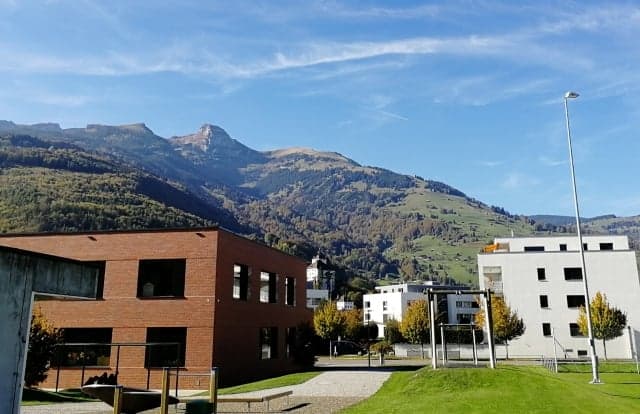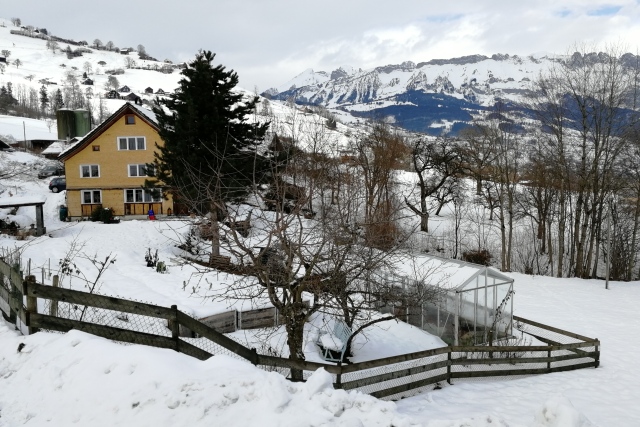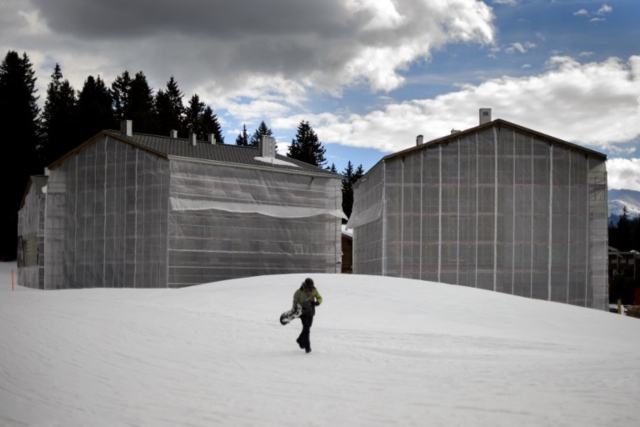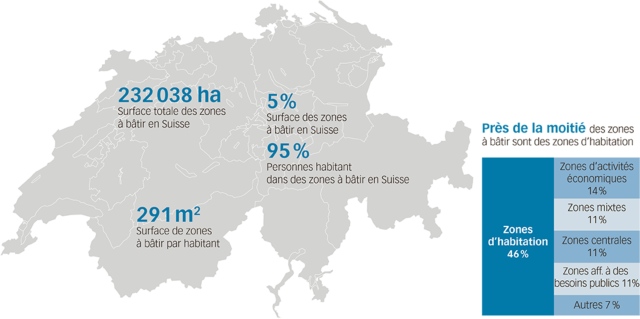Explained: the referendum that aims to save the Swiss countryside

On February 10th Swiss voters will be voting in a referendum on whether Switzerland should put a freeze on the amount of land designated as building zones, or land set aside for construction. Here is what you need to know.
The so-called 'urban sprawl' referendum has divided Swiss voters, Many say the initiative is essential to protect Switzerland's countryside while many others argue it could stymie the country's economic growth and tie its hands when it comes to planning for future housing needs.
The background to the vote
The issues of urban sprawl and the disappearance of the countryside have been hot topics in Switzerland in recent years.
While the country can seem like a natural paradise to outsiders, a lack of urban planning over many decades, increased demand for housing and infrastructure because of a rapidly growing population and property speculation have all raised fears among the Swiss – for whom the countryside is integral to the national sense of self – that the country is about to turn into one large suburb.

Landscapes like the one above are an essential part of the Swiss psyche. Photo: The Local
In response to these concerns, and in belated recognition of the fact that land is a finite resource in small Switzerland, federal authorities carried out a major revision of the Spatial Planning Act. This was then backed by Swiss voters in a referendum in 2013.
Those 2013 changes were designed to tighten up planning processes. Under the revised law, building zones across the country “must be defined in such a manner that they meet the anticipated needs for the following 15 years”.
Read also: How Switzerland's direct democracy system works
The legislation also stipulates excessively large building zones must be reduced in size.
But the youth wing of the Greens – the Young Greens – argue the 2013 revision doesn’t go far enough and will not put a stop to future development.
In 2016, the youth wing of the Greens, the Young Greens, launched its "Stop urban sprawl - for sustainable urban development initiative” in a bid to stop over-development.
The initiative sees the party calling for measures to end creeping urban sprawl to be enshrined in the constitution as opposed to being spelled out in legislation, as is currently the case. This would give the measures greater legal weight.
The initiative in a nutshell
The urban sprawl initiative aims to freeze the entire area of building zones in Switzerland at their current level. This would mean a new building zone could only be approved if an area elsewhere of at least the same size and same agricultural potential were to be declassified as a building zone.

Holiday chalets being built in Lenzerheide in the canton of Graubünden in 2013. Photo: AFP
Under the terms of the initiative, the only buildings or infrastructure which could be built outside of land designated as building land would be those in the public interest – such as streets or cable cars – or those which are necessary for sustainable agriculture.
The initiative would also require federal and local authorities to promote sustainable forms of living and working.
What do the supporters argue?
Alongside the Greens, backers of the urban sprawl initiative include Switzerland’s Socialist Party and groups such as bicycle organisation Pro Velo, Greenpeace and Mountain Wilderness.
These parties and organizations argue that their initiative will ensure quality of life is maintained, enough land remains available for sustainable agriculture, and the Swiss landscape will be protected for future generations.
Supporters also say there is currently enough building land in reserve to meet future housing needs and that their initiative will lead to better use of those reserves. See the section below on whether the urban sprawl initiative is necessary for more detail on this.
What do the opponents say?
Opponents of the initiative include the Swiss government, the Swiss parliament, the right-wing Swiss People's Party (SVP), centre-right parties the Liberals (FDP) and Christian Democrats (CVP) and groups such as the business lobby Economiesuisse, the Swiss Homeowners Association and the Swiss Farmers’ Union.
The Swiss government argues the initiative is too inflexible. Stating its objections in the information booklet sent out to all Swiss voters before referendums, the Federal Council said a freeze on the amount of land zoned for building failed to meet the needs of the Swiss population and the economy and could make Switzerland less competitive.

Demand for land in urban areas (like Zurich, pictured) is expected to grow in coming years. Photo: AFP
The government said it recognized it was important to protect the environment and the countryside and argued that the 2013 changes to planning laws would ensure green spaces continue to exist.
But it argued the proposed freeze on new building land failed to take regional and cantonal differences into consideration.
It would also punish cantons that had taken a more restrained approach to planning and had not set aside as much land for building zones, the government said.
The initiative could also lead to rising house and land prices in areas where building land was in short supply, the Federal Council argued.
Finally, the government has also noted it is not clear how mechanisms to reclassify and redistribute building land would work under the terms of the urban sprawl initiative. Specifically, there is a question mark over whether this process would work across cantonal borders.
Is the initiative necessary?
In 2017, there were 232,038 hectares of building land in Switzerland, which is around 7.5 percent of the total area of the country. Almost 95 percent of the population lived in this area.
Of these 232,038 hectares designated as building land, more than 80 percent had already been developed.
However, there is, “in theory”, enough undeveloped building land remaining for 1 million to 1.7 million more residents, according to Switzerland’s Federal Office for Spatial Development (ARE).

Image: Swiss Federal Office for Spatial Development
But the agency notes that this land is unevenly distributed and that much of it is in tourism and farming areas where it will not be required in the next 15 years. Meanwhile, there is likely to be increased need for land in urban areas which are experiencing strong growth.
Supporters of the urban sprawl initiative argue a freeze is necessary to ensure proper management of this remaining building land.
But the federal government notes the revised planning law of 2013 is still being implemented. Cantons have until April this year to submit their 15-year development plans to Bern for approval in a process the federal government argues will help protect the Swiss countryside in future.
The government also notes that the amount of building land in Switzerland has actually fallen from a 2012 peak of 309 square metres per person to 291 square metres in 2017.
Will voters back the initiative?
A poll run by Swiss media group Tamedia just before Christmas put support for the urban sprawl initiative at 54 percent. Support was highest among people who vote for left-wing parties while voters for the SVP were also in favour.
But a majority of voters for the FDP and CVP said they would vote no.
However, the organisers of the poll noted that many people were yet to make up their mind as to how they would vote.
Comments
See Also
The so-called 'urban sprawl' referendum has divided Swiss voters, Many say the initiative is essential to protect Switzerland's countryside while many others argue it could stymie the country's economic growth and tie its hands when it comes to planning for future housing needs.
The background to the vote
The issues of urban sprawl and the disappearance of the countryside have been hot topics in Switzerland in recent years.
While the country can seem like a natural paradise to outsiders, a lack of urban planning over many decades, increased demand for housing and infrastructure because of a rapidly growing population and property speculation have all raised fears among the Swiss – for whom the countryside is integral to the national sense of self – that the country is about to turn into one large suburb.

Landscapes like the one above are an essential part of the Swiss psyche. Photo: The Local
In response to these concerns, and in belated recognition of the fact that land is a finite resource in small Switzerland, federal authorities carried out a major revision of the Spatial Planning Act. This was then backed by Swiss voters in a referendum in 2013.
Those 2013 changes were designed to tighten up planning processes. Under the revised law, building zones across the country “must be defined in such a manner that they meet the anticipated needs for the following 15 years”.
Read also: How Switzerland's direct democracy system works
The legislation also stipulates excessively large building zones must be reduced in size.
But the youth wing of the Greens – the Young Greens – argue the 2013 revision doesn’t go far enough and will not put a stop to future development.
In 2016, the youth wing of the Greens, the Young Greens, launched its "Stop urban sprawl - for sustainable urban development initiative” in a bid to stop over-development.
The initiative sees the party calling for measures to end creeping urban sprawl to be enshrined in the constitution as opposed to being spelled out in legislation, as is currently the case. This would give the measures greater legal weight.
The initiative in a nutshell
The urban sprawl initiative aims to freeze the entire area of building zones in Switzerland at their current level. This would mean a new building zone could only be approved if an area elsewhere of at least the same size and same agricultural potential were to be declassified as a building zone.

Holiday chalets being built in Lenzerheide in the canton of Graubünden in 2013. Photo: AFP
Under the terms of the initiative, the only buildings or infrastructure which could be built outside of land designated as building land would be those in the public interest – such as streets or cable cars – or those which are necessary for sustainable agriculture.
The initiative would also require federal and local authorities to promote sustainable forms of living and working.
What do the supporters argue?
Alongside the Greens, backers of the urban sprawl initiative include Switzerland’s Socialist Party and groups such as bicycle organisation Pro Velo, Greenpeace and Mountain Wilderness.
These parties and organizations argue that their initiative will ensure quality of life is maintained, enough land remains available for sustainable agriculture, and the Swiss landscape will be protected for future generations.
Supporters also say there is currently enough building land in reserve to meet future housing needs and that their initiative will lead to better use of those reserves. See the section below on whether the urban sprawl initiative is necessary for more detail on this.
What do the opponents say?
Opponents of the initiative include the Swiss government, the Swiss parliament, the right-wing Swiss People's Party (SVP), centre-right parties the Liberals (FDP) and Christian Democrats (CVP) and groups such as the business lobby Economiesuisse, the Swiss Homeowners Association and the Swiss Farmers’ Union.
The Swiss government argues the initiative is too inflexible. Stating its objections in the information booklet sent out to all Swiss voters before referendums, the Federal Council said a freeze on the amount of land zoned for building failed to meet the needs of the Swiss population and the economy and could make Switzerland less competitive.

Demand for land in urban areas (like Zurich, pictured) is expected to grow in coming years. Photo: AFP
The government said it recognized it was important to protect the environment and the countryside and argued that the 2013 changes to planning laws would ensure green spaces continue to exist.
But it argued the proposed freeze on new building land failed to take regional and cantonal differences into consideration.
It would also punish cantons that had taken a more restrained approach to planning and had not set aside as much land for building zones, the government said.
The initiative could also lead to rising house and land prices in areas where building land was in short supply, the Federal Council argued.
Finally, the government has also noted it is not clear how mechanisms to reclassify and redistribute building land would work under the terms of the urban sprawl initiative. Specifically, there is a question mark over whether this process would work across cantonal borders.
Is the initiative necessary?
In 2017, there were 232,038 hectares of building land in Switzerland, which is around 7.5 percent of the total area of the country. Almost 95 percent of the population lived in this area.
Of these 232,038 hectares designated as building land, more than 80 percent had already been developed.
However, there is, “in theory”, enough undeveloped building land remaining for 1 million to 1.7 million more residents, according to Switzerland’s Federal Office for Spatial Development (ARE).

Image: Swiss Federal Office for Spatial Development
But the agency notes that this land is unevenly distributed and that much of it is in tourism and farming areas where it will not be required in the next 15 years. Meanwhile, there is likely to be increased need for land in urban areas which are experiencing strong growth.
Supporters of the urban sprawl initiative argue a freeze is necessary to ensure proper management of this remaining building land.
But the federal government notes the revised planning law of 2013 is still being implemented. Cantons have until April this year to submit their 15-year development plans to Bern for approval in a process the federal government argues will help protect the Swiss countryside in future.
The government also notes that the amount of building land in Switzerland has actually fallen from a 2012 peak of 309 square metres per person to 291 square metres in 2017.
Will voters back the initiative?
A poll run by Swiss media group Tamedia just before Christmas put support for the urban sprawl initiative at 54 percent. Support was highest among people who vote for left-wing parties while voters for the SVP were also in favour.
But a majority of voters for the FDP and CVP said they would vote no.
However, the organisers of the poll noted that many people were yet to make up their mind as to how they would vote.
Join the conversation in our comments section below. Share your own views and experience and if you have a question or suggestion for our journalists then email us at [email protected].
Please keep comments civil, constructive and on topic – and make sure to read our terms of use before getting involved.
Please log in here to leave a comment.